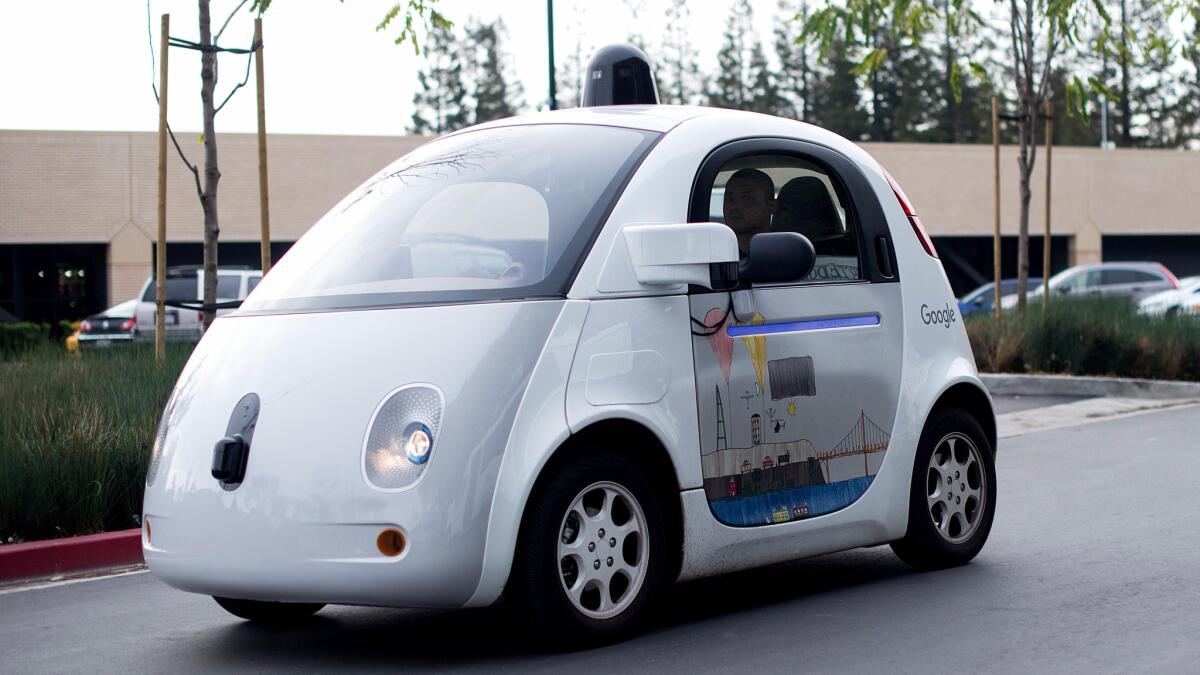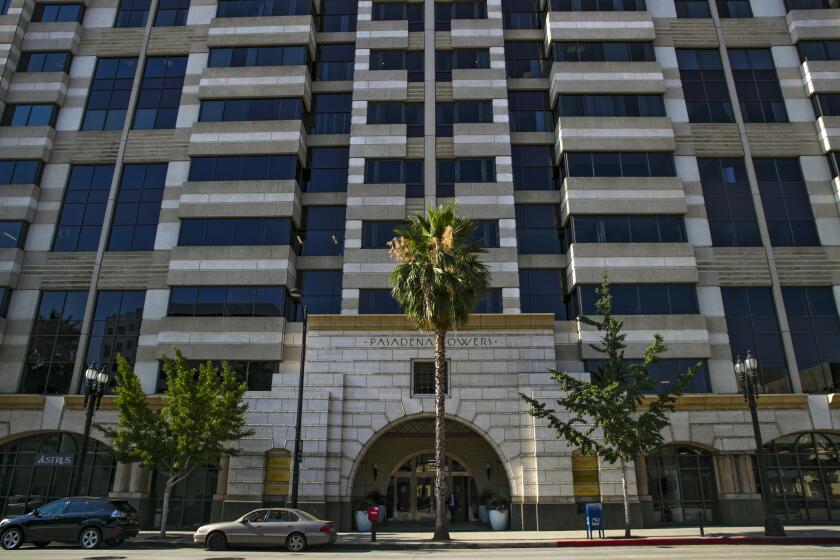Column: Is the world ready for driverless cars? Are driverless cars ready for the world?

Here’s a quiz you can take at home:
When will driverless cars become common on America’s highways?
A. They’re already here!
B. Ten to 20 years from now.
C. In 225 years.
It’s a trick question. Each answer is correct, depending on how you define driverless technologies and the rules and regulations needed to oversee them. Intelligent cruise control and self-parking systems are common on new cars today. According to Eric Schmidt, the chairman of Alphabet (the parent company of Google), even more advanced driverless technologies are ready, and hidebound regulators are the only obstacle to their widespread use.
“The technology works because, frankly, the computer can see better than you can, even if you’re not drunk in a car,” Schmidt, whose company’s self-driving vehicles have completed 1.5 million miles of test drives, told a receptive audience Monday at the Milken Institute Global Conference.
Before now, new vehicle technologies have just been allowed to go on the road. ... The public may not be comfortable following the same path for autonomous vehicles.
— Nidhi Kalra, Rand Corp.
Many automotive and technology experts, however, expect that fully developing the technology and perfecting regulations for two-ton vehicles tooling around our roads without a human at the controls will take a decade or two. And determining to a statistical certainty whether autonomous vehicles are safer will take even longer.
A recent study by the Rand Corp. calculated that establishing to a statistical near-certainty that driverless cars would reduce vehicular fatalities by even 20% would require 5 billion miles of road testing -- a record that would take a fleet of 100 test vehicles 225 years to complete if they operatied at an average of 25 miles per hour, 24 hours a day and 365 days a year. That’s because Americans drive 3 trillion miles a year and fatalities are relatively rare -- the 32,800 deaths annually on U.S. roads amount to only 1.09 per 100 million miles.
It’s unclear whether the public will demand such precise proof of safety before accepting driverless cars on the road, says Nidhi Kalra, the co-author of the Rand report. “Before now, new vehicle technologies have just been allowed to go on the road because the driver is still ultimately in control,” Kalra says. “The public may not be comfortable following the same path for autonomous vehicles.”
As automaking increasingly becomes a high-tech industry, California is turning into the hub of autonomous vehicle research and development. Google’s self-driving car initiative is based near the company’s Mountain View headquarters, with a test range in Merced County. Tesla Motors, another hotbed of autonomous vehicle research, is based in Palo Alto, where the Toyota Research Institute, that automaker’s artificial intelligence and robotics division, also recently established one of its three labs. (The others are in Cambridge, Mass., and Ann Arbor, Mich.)
California’s importance to these efforts became clear in December, when the state transportation agency issued regulations governing the testing of self-driving cars on public roads. Among other requirements, companies must equip their test vehicles with a steering wheel and a licensed and specially-trained operator prepared to take over immediate control, and must put up a $5-million insurance bond.
The driverless car lobby immediately denounced the regulations as a “ban” on driverless cars. Chris Urmson, the head of Google’s program, groused that requiring a self-driving car “to have a licensed driver at all times ... maintains the same old status quo and falls short on allowing this technology to reach its full potential, while excluding those who need to get around but cannot drive.”
In fact, the regulations govern only testing of the cars; operating vehicles without drivers is still illegal on public roadways in California. The rules are aimed at ensuring that test vehicles can safely share the roads with everyone else, says Brian Kelly, head of the transportation agency.
Several workshops and public hearings on the regulations showed the agency that “consumer and safety advocacy groups are very cautious about letting go of things like steering wheels and brakes in cars,” he told me. “We’re not trying to shut down testing, but make sure we can safely bring it along.”
Kelly said that California and other states are hoping that the National Highway Transportation Safety Agency will take the lead in overseeing testing rules by issuing draft regulations later this year.
There’s no question that self-driving cars could bring significant benefits to the traveling public. Proponents point to the role of human error in the vast majority of vehicular accidents -- a reminder of the old joke about the most dangerous part of a car is “the nut behind the wheel.” Autonomous vehicles won’t get drunk or distracted reading or writing texts. Efficiently-driven robotic cars could reduce congestion and pollution, and provide mobility to people barred from driving themselves, such as the elderly and the blind.
The promise of new technologies is hinted at by the success of robotic features built into many cars now: adaptive cruise control, which adjusts the car’s speed when it senses traffic or obstructions in its way; lane-departure warnings and emergency braking; and self-parking systems.
Some automakers see advanced technologies as potential revenue bonanzas. New cars are coming equipped with capabilities to acquire and transmit vast quantities of data about road conditions, vehicle locations, and even the drivers’ vital signs.
Questions abound about who owns such data and how it can be kept secure from prying eyes. But “there’s potential for business models that would monetize the car” in the same sense that Facebook or Google extract profit from bundling users’ data for sale, says Chris Ballinger, chief financial officer of Toyota Financial Services. Among the options being considered by Toyota is offering drivers a price or financing discount if they agree to allow their car’s data to be exploited by the company.
Current technologies all require the driver to remain alert and ready to take full control of the car to ensure safety. What of the self-driving technologists’ dream of a car so autonomous that its occupant can read, work or nap while traveling? Huge questions remain about when -- or whether -- advanced technology will ever render such cars safe in all road conditions, at least as far as the public is concerned. A recent survey by J.D. Power found that mistrust of fully automated cars spans all age groups.
Assertions that robotic technology is ready to outperform human drivers seems wildly premature. The real-world performance of visual technology contradicts Schmidt’s claim that “the computer can see better than you can.” That’s true only in certain conditions.
Google’s computer-guided cars depend on intricate prior mapping of routes and environments, and can be confounded by unexpected features, such as temporary traffic signs or signals and fog, rain or snow. Humans are still better than computers at reliably distinguishing between features of the landscape that resemble each other in shape and size but require very different responses -- a pedestrian vs. a police officer, for instance. Google has said that its system’s perception abilities are getting better all the time, and that its automotive algorithms will react to murky or perplexing conditions by slowing down.
One issue that may never be resolved involves the moral component of driving decisions. This is often illustrated through the “trolley problem.” In one of the almost infinite variations, a runaway trolley is about to hit and kill a group of bystanders who can only be saved by steering the trolley into a wall, which would kill all its occupants. What if the bystanders or the occupants are children?
Society accepts that a human driver might make the wrong decision in a split second -- if there even is a “right” one -- but might not be willing to cede the judgment to an algorithm. State and local laws aren’t close to determining legal responsibility when a driverless car causes injury or damage -- and that’s just one of the many predictable potholes on the way to a driverless vehicular future. The unforeseen potholes may be even more numerous.
“We have good reason to believe that autonomous vehicles will be safer -- they’re never drunk or tired or distracted,” says Rand’s Kalra. “What we don’t know is what kinds of errors they may introduce. Where humans fail the most may not be where autonomous vehicles do. They may fail in entirely new ways.”
Keep up to date with Michael Hiltzik. Follow @hiltzikm on Twitter, see his Facebook page, or email michael.hiltzik@latimes.com.
Return to Michael Hiltzik’s blog.
More to Read
Inside the business of entertainment
The Wide Shot brings you news, analysis and insights on everything from streaming wars to production — and what it all means for the future.
You may occasionally receive promotional content from the Los Angeles Times.











